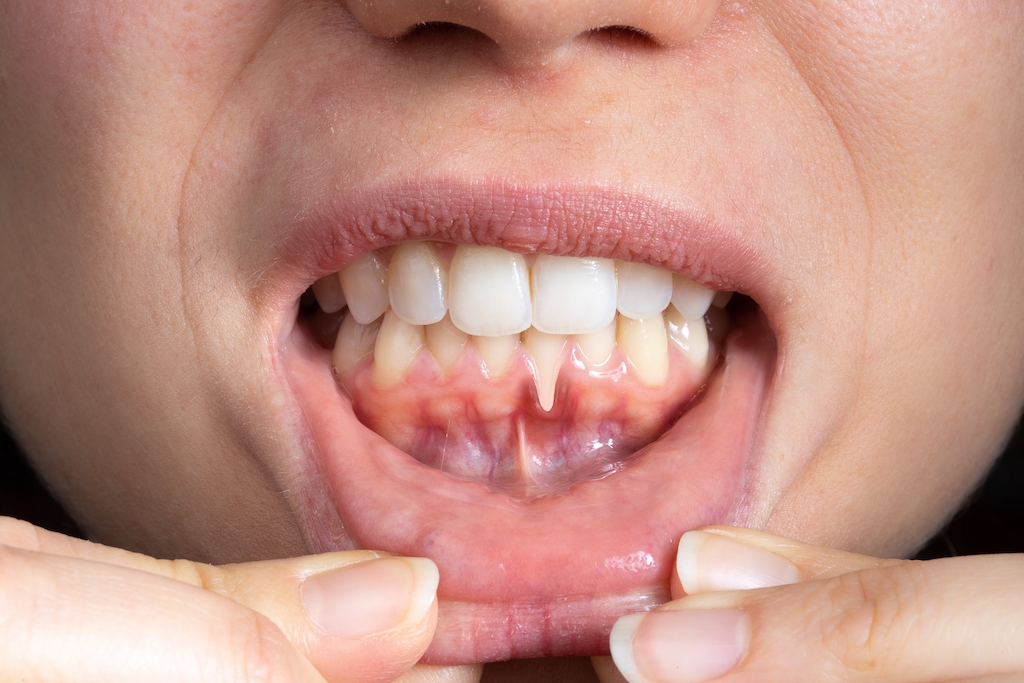 Photo Credit: Courtesy of sruilk/Shutterstock
Photo Credit: Courtesy of sruilk/Shutterstock
Are you beginning to observe changes in the appearance of your teeth, with the surface or root becoming increasingly exposed? If so, you may be experiencing a condition known as gum recession. Gum recession occurs when the protective gum tissue surrounding your teeth begins to deteriorate or recede. Here we will explore the common signs and symptoms of gum recession, shedding light on this dental concern as well as its potential causes and available treatments.
Visible Gum Tissue Changes
You may notice that your teeth appear longer than before, or you can see the root surface of one or more teeth.
Tooth Sensitivity: As the protective gum tissue recedes, the sensitive part of the tooth (dentin) can become exposed. This can lead to increased sensitivity to hot or cold foods and beverages, as well as air.
Notching at the Gumline: Small, V-shaped notches may appear at the gumline, indicating erosion of the gum tissue.
Spaces Between Teeth: As the gums recede, the gaps between your teeth may appear wider.
Bleeding Gums: Gums that bleed easily, especially during brushing or flossing, can be a sign of gum recession. This may be due to the gum tissue becoming thinner and more fragile.
Redness and Swelling: Inflamed or swollen gum tissue may indicate recession, as the tissue may become more susceptible to irritation and infection.
Bad Breath (Halitosis): Receding gums can create pockets or spaces between the teeth and gums where bacteria can accumulate, leading to bad breath.
Loose Teeth: In advanced cases of gum recession, teeth may become loose as the supporting structures, including the bone, are affected.
Changes in Tooth Alignment: As the gums recede, teeth may shift or become misaligned.
Visible Roots: In some cases, you may be able to see the exposed tooth roots, which can have a yellowish color.
 Photo Credit: Courtesy of Arthur Bargan/Shutterstock
Photo Credit: Courtesy of Arthur Bargan/Shutterstock
Common Treatments and Approaches
Treatment for gum recession depends on the severity of the condition and its underlying causes. Here are some common treatments and approaches used to address gum recession:
Improved Oral Hygiene: In mild cases of gum recession caused by poor oral hygiene, the first step is often to improve your oral care routine. This includes proper brushing techniques, using a soft-bristle toothbrush, and daily flossing to prevent further gum recession and promote gum tissue health.
Scaling and Root Planing: If gum recession is caused by gum disease (periodontitis), a deep cleaning procedure called scaling and root planing may be recommended. This involves removing plaque and tartar from the tooth’s surface and root to encourage gum tissue reattachment.
Gum Grafting: This is a common surgical procedure used to treat moderate to severe gum recession. During a gum grafting procedure, a small piece of tissue is taken from another area of your mouth (usually the roof of the mouth) or from a tissue bank and attached to the receded area. This helps cover the exposed root and encourages gum tissue regeneration.
Pinhole Surgical Technique (PST): PST is a minimally invasive surgical method for treating gum recession. It involves creating small holes in the gum tissue and gently repositioning the existing tissue to cover the exposed root. No grafts or sutures are needed, and recovery time is often quicker compared to traditional grafting procedures.
Regenerative Procedures: In some cases, regenerative techniques may be used to stimulate the growth of new bone and tissue to restore the gumline. This can include bone grafts, membrane placement, and tissue-stimulating proteins.
Orthodontic Treatment: If misaligned teeth are contributing to gum recession, orthodontic treatment to correct the alignment of the teeth may be recommended.
Medications: Depending on the cause of gum recession, your dentist or periodontist may prescribe medications such as antibiotics to manage gum disease or special toothpaste for sensitive teeth.
Lifestyle Changes: If habits like smoking or excessive teeth grinding are contributing to gum recession, making necessary lifestyle changes can help prevent further recession.
Routine Dental Check-ups: Regular dental check-ups are essential for monitoring the progression of gum recession and adjusting the treatment plan as needed.
It’s important to note that gum recession can be caused by various factors, including poor oral hygiene, gum disease, aggressive tooth brushing, genetics, smoking, hormonal changes, and certain medical conditions. If you suspect you have gum recession or notice any of these signs, it’s essential to consult a dentist or periodontist (gum specialist) for a proper evaluation and appropriate treatment. Early detection and intervention can help prevent further recession and preserve your oral health. The appropriate treatment for gum recession will be determined by your dentist or periodontist after a thorough evaluation of your oral health. Early intervention is crucial to prevent further damage and complications, so if you suspect you have gum recession or notice any related symptoms, it’s important to seek professional dental care.
For more information, visit Dr. Brian A. Levine's social media:

























